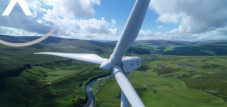Published on: May 21, 2025 / update from: May 21, 2025 - Author: Konrad Wolfenstein

The importance of the Modal Split and the role of dual-use logistics in transport policy-creative image: Xpert.digital
Innovative logistics approaches: Dual -use as a solution at the interface
Flexible, effective, scalable and fast mobility through Modal Split and smart logistics
The Modal Split is one of the most important indicators for traffic planning and politics in Germany. With regard to the ambitious climate protection goals, relocation from the street to more environmentally friendly modes of transport is becoming increasingly important. This report analyzes the meaning of the Modal Split and particularly illuminates the role of dual-use logistics at the interface between the street and rail.
Suitable for:
- Transport performance with rail freight transport - efficiency, security and climate protection: 1,404 tons of freight train vs. 52 trucks
Definition and meaning of the Modal Split
In the traffic statistics, the distribution of the transport volume on various modes of transport or means of transport is referred to as Modal Split (often also modal split). The term is derived from the Latin “mode” (type of the chosen means of transport) and the English verb “to split” (divide, split). Another common term in this context is “choice of transport”.
The Modal Split describes the mobility behavior and its composition depends, among other things, on the respective transport offer and economic decisions. It is related to different key figures, such as the person kilometers or toned kilometers covered in freight transport. In relation to the traffic performance, the Modal Split is the crucial size, since changes in the modal split share of environmentally friendly modes of transport allow conclusions to be drawn about the development of the external costs of traffic.
The Modal Split thus represents the most important indicator of optimizing traffic with regard to ecological, social and economic requirements. It is used, for example, in urban planning and in the development of sustainability concepts. The market share of the rail in freight transport is even one of the sustainability indicators part of the report “Sustainable Development in Germany” of the Federal Statistical Office.
The current situation in freight transport
The total traffic service of freight transport in Germany in 2023 was 674.5 billion tons of kilometers. The current proportion of rail in Germany is around 18-20%, while road freight transport is dominated by around 71-73%. In the coalition agreement, the traffic light coalition had set the ambitious goal of increasing the proportion of rail freight transport to Modal Split to 25% by 2030.
This increase of 6.5 percentage points sounds manageable at first glance, but in absolute numbers it means an increase of 129.9 billion to 210 billion tons of kilometers - an increase of around 60 percent. In order to achieve this goal, the traffic performance of rail freight transport must grow by around 5.5 percent annually. The freight lanes even consider it possible that the increase can be even higher under certain conditions and die 264 billion tons of kilometers by 2035, i.e. a doubling of the status quo.
The importance of dual-use logistics
Definition and concept
The term “dual -use” traditionally describes goods, software and technologies that can be used for both civilian and military applications. In the context of the logistics infrastructure, however, this term experiences a strategic expansion. Dual-use logistics refers to traffic infrastructures that can be used for both civil and military purposes.
The modern logistics landscape of Europe faces a double challenge: it must increase the efficiency and sustainability of civilian supply chains and at the same time meet the increased demands on military mobility in a changing geopolitical environment. In this context, the concept of dual-use logistics, especially in combined traffic (KV) Schiene-Straße, is becoming more important.
Promotion at European and national level
The importance of dual-use logistics has increased particularly since Russia's attack on Ukraine, since Germany also functions for military transport as a logistical linchpin for Europe. Federal Transport Minister Volker Wissing emphasized: "Germany is a logistical linchpin for Europe. In addition to the regular economic descriptions, this has also been particularly important for military transports since Russia's attack on Ukraine. [...] For the defense of Europe, we need a strong rail".
Suitable for:
- Regiolog Süd | Dual-us logistics infrastructure Pilot project: for civil resilience and military operational readiness
The EU actively promotes the development of such dual-use infrastructures. The Federal Ministry of Digital and Transport (BMDV) has succeeded in advertising funding for German dual-use projects over the past three years of more than 296 million euros. The BMDV's funding applications focus on railways and measures that serve to improve the navigation of the ten-V nuclear network corridors with long, heavy freight trains and the improvement of envelope capacities for rail freight transport.
Suitable for:
- Goods from the street on the rail: Logistics hobs & high-tech-locations for envelope, logistics, trade and production
Combined traffic as a key strategy
Definition and functionality
Combined traffic (KV), also known as combined load transactions (KLV) or combined freight transport, describes a multi-part transport or supply chain in logistics that integrated different modes of transport. The combined traffic can be viewed as the key to a stronger shift to the rail and is part of the “green logistics”.
The European Conference of Transport Ministers defines the combined traffic as intermodal traffic, in which the vast majority of the route covered with the railway, with the internal or sea shipping is mastered and the lead on the street is kept as short as possible. In combined traffic, loading units (containers, interrogation or truck saddle trailers) are transported over longer distances on the rail or the waterway.
Advantages and potential
Combined traffic is used to optimally use the strengths of different modes of transport. Railway, inland navigation and seagoing traffic can only be used economically from relatively large distances and high freight transport. They are therefore well suited for combination with the temporally and spatially flexible truck traffic, which takes over the small-scale distribution (in front and wasting on the street).
Intermodal traffic enables cost optimization, especially for long -distance transports. Other advantages include flexibility, security of goods and adherence to the Incoterms. In this segment, the highest growth rates are achieved, which shows the success of this concept.
Measures to achieve the 25%goal by 2030
Various measures were initiated in order to achieve the goal of a 25%share of rail freight transport at Modal Split by 2030. In the coalition agreement, it is stipulated to further develop the rail freight traffic master plan and to implement it quickly. The master plan comprises 66 measures in ten fields of measures and five immediate measures.
The most important measures include:
- Lowering the route prices: Since July 1st, 2018, the BMDV has been promoting the route prices in rail freight transport at 350 million euros annually. It is expected that the railway traffic companies will invest part of the funds saved in order to modernize the SGV and pass on another part to customers through prices.
- Federal program “Future Schiens freight transport”: This program, which started on May 20, 2020, is a targeted impulse provider for efficient and modern rail freight transport in Germany with the aim of sustainable the reliability, economy and logistics ability of rail freight traffic.
- Promotion of combined traffic: In addition to regulatory relief (increased maximum weight of the trucks of 44 tons, exceptions to Sundays, holiday or holiday driving bans, liberation The vehicles used exclusively for the forecast and in-depth run from motor vehicle tax) takes place, especially in the area of the establishment of freight traffic centers (envelope termination) by federal government and the EU.
- Introduction of the digital automatic coupling (DAK): The Europe -wide migration of the DAK promises capacity profits and is intended to drive the growth of the SGV sustainably.
Environmental and economic advantages of relocation to the rail
The relocation of freight traffic to rail offers significant environmental advantages. In the transport sector, greenhouse gas emissions have not been reduced for decades. The climate goals for 2030 can therefore only be achieved if much more is shifted to the rail, which saves 80 percent of CO2 emissions compared to the road and is also five times more energy-efficient.
A study by the Fraunhofer Institute for System and Innovation Research ISI on behalf of the Expert Commission Research and Innovation (EFI) has examined the development of car-based shared mobility services and found that financial support for shared mobility services through the public sector and integration into the existing public transport is necessary.
Suitable for:
Combined traffic: ecological advantages through intelligent infrastructure
The Modal Split is a crucial indicator of the design of a sustainable and efficient transport policy. The increase in the proportion of rail freight transport to 25% by 2030 is a major challenge that requires considerable efforts. The dual-use logistics and combined traffic play a key role because they can improve the efficiency and economy of rail freight transport.
The promotion of dual-use infrastructures by the EU and national governments creates synergies between civil and military requirements and contributes to the resilience of European transport infrastructure. The combined traffic combines the strengths of various modes of transport and offers both ecological and economic advantages.
In order to achieve the 25%goal, however, considerable investments in the rail infrastructure, the digitization of rail freight transport and the promotion of combined traffic are still necessary. Only through a coordinated procedure of all involved - politics, railway companies and the shipping company - can the desired turnaround in goods be transported in freight transport.
Suitable for:
Advice - planning - implementation
I would be happy to serve as your personal advisor.
Head of Business Development
Chairman SME Connect Defense Working Group
Advice - planning - implementation
I would be happy to serve as your personal advisor.
contact me under Wolfenstein ∂ Xpert.digital
call me under +49 89 674 804 (Munich)

















